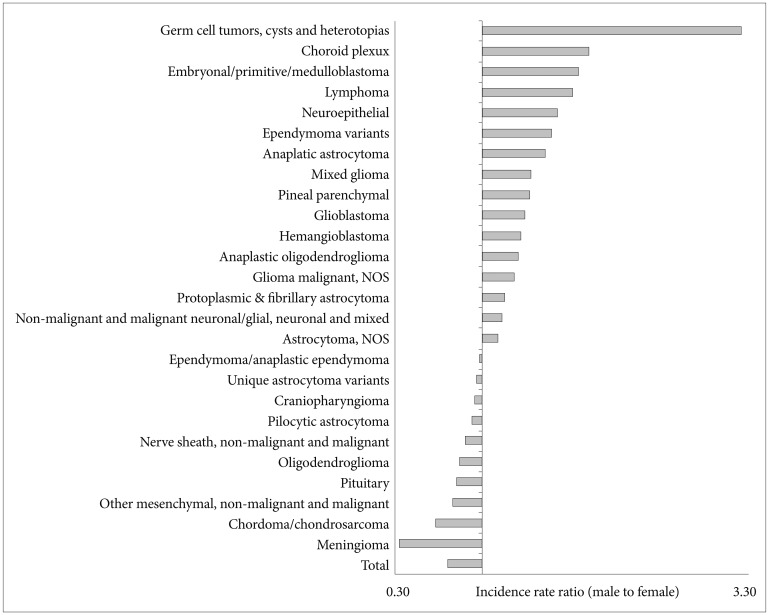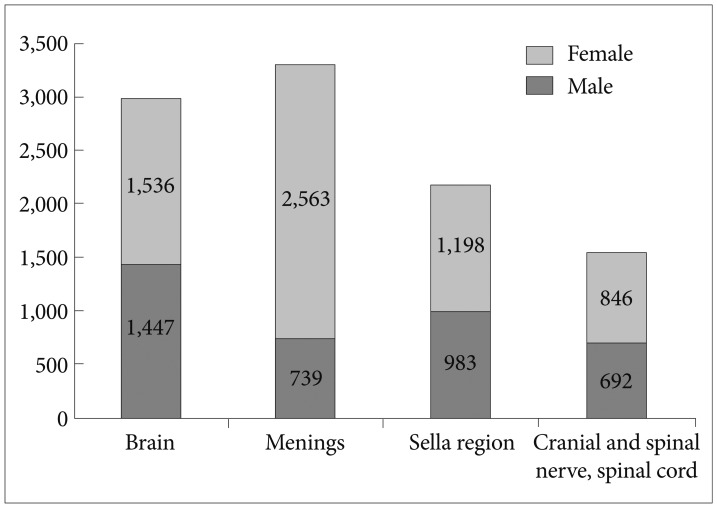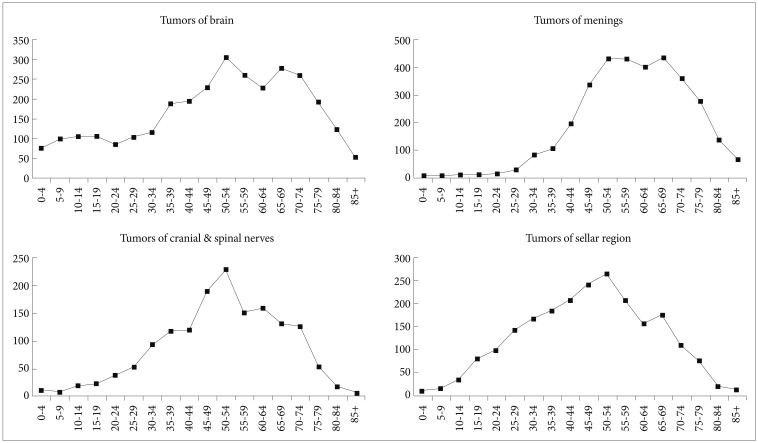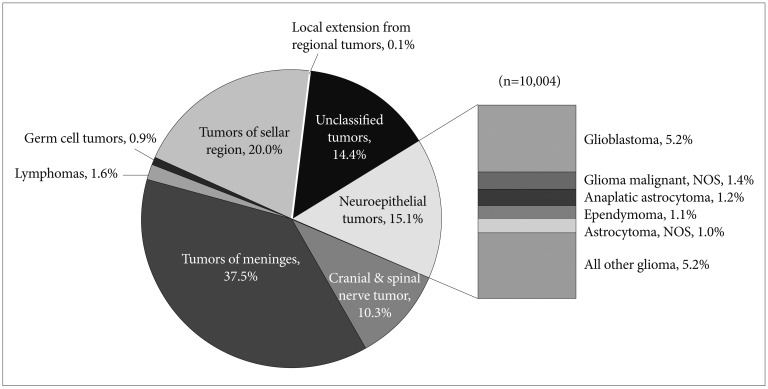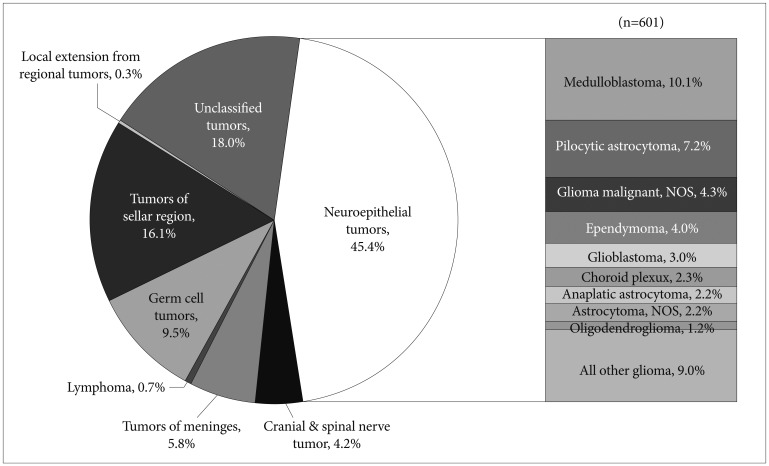Abstract
Objective
The aim of this report is to provide accurate nationwide epidemiologic data on primary brain and central nervous system (CNS) tumors in Republic of Korea. In 2010, we had reported first nationwide epidemiologic data on primary brain tumors diagnosed in 2005. In this report, we updated the data by analyzing primary brain and CNS tumors diagnosed in 2010 using the data from national cancer incidence database.
Methods
Data on primary brain and CNS tumors diagnosed in 2010 were collected from the Korean Central Cancer Registry. Crude and age-standardized rates were calculated in terms of gender, age, and histological type.
Results
A total of 10,004 patients diagnosed with primary brain and CNS tumors in 2010 were included in this study. Brain and CNS tumors occurred in females more often than in males (female to male, 1.59 : 1). The most common tumor was meningioma (35.5%). Pituitary tumors (18.7%), gliomas (15.1%), and nerve sheath tumors (10.3%) were followed in incidence. Glioblastoma accounted for 34.6% of all gliomas. In children (<20 years), sellar region tumors (pituitary and craniopharyngioma), embryonal/primitive/medulloblastoma, and germ cell tumors were the most common tumors.
Conclusion
Data from this study should provide valuable information regarding the primary brain tumors epidemiology in Republic of Korea.
Keywords: Epidemiology, Brain, Central nervous system, Tumor, Registry, Korea
INTRODUCTION
Primary brain and central nervous system (CNS) tumors are not common. However, the incidence of brain and CNS tumors has increased gradually [1-3]. These tumors may result in mental alteration and neurologic deficits, and the social burden of brain tumors is just as large as that of other tumors. An accurate understanding of the epidemiology is needed to facilitate early detection and treatment. Many countries have established brain tumor registries, and their descriptive epidemiology have been reported [1,2,4-7].
The Korean Ministry of Health and Welfare started a nationwide, hospital-based cancer registry (Korea Central Cancer Registry, KCCR) in 1980. In 2005, the first national cancer incidence between 1999 and 2001 were reported by the KCCR [8]. The KCCR database was especially useful for showing trends of cancer occurrence in Republic of Korea. However, it only provided the incidence of malignant brain tumors, excluding benign and borderline tumors.
Since benign brain tumors can recur and may be inoperable, non-malignant brain tumors may impose the same cost on the society in terms of medical care and case fatality as malignant brain tumors.
In order to include benign and borderline tumors of the brain and CNS, the KCCR revised its criteria for cancer registration in 2004, and started national collection of nonmalignant brain tumors since 2005. As a result, there was a first nationwide epidemiologic report in 2010 by analyzing registered tumors in 2005 [9]. In this report, we updated the data by analyzing primary brain and CNS tumors diagnosed in 2010 using the data from the KCCR.
The objective of this report is to provide an accurate nationwide incidence of primary malignant and nonmalignant brain tumors in Korean by sex, age group, topography and histological type.
MATERIALS AND METHODS
Brain tumor registration
A total of 10,004 brain and CNS patients diagnosed in 2010 were registered by 352 hospitals. Basic information such as the demographic characteristics of patients, date of diagnosis, tools of diagnosis, topography and histological type according to the International Classification of Diseases for Oncology, third edition (ICD-O-3) were collected by the KCCR [10].
Data processing
Primary brain and CNS tumors with the following ICD-O-3 codes were included in the analysis: brain (C71.0-C71.9), meninges (C70.0-C70.9), spinal cord, cranial nerves and other parts of the CNS (C72.0-C72.9), and pituitary gland, craniopharyngeal duct and pineal gland (C75.1-C75.3). Their behavior was also classified by the ICD-O-3 code, which are divided into 3 groups: benign, uncertain whether benign or malignant, and malignant. Tumors with behavior codes (fifth digit ICD-O morphology) 0, 1 and 3, respectively, were also included. Histology groupings were based on the classification of the Central Brain Tumor Registry of the United States (CBTRUS) [2]. These groupings were broadly based on the World Health Organization categories for brain tumors.
The population size used as a denominator to calculate cancer incidence was the midyear population on 1 July. In this report, we modified the registered population released annually from the national statistics office to obtain the midyear population [11]. Childhood tumors were defined as those diagnosed in patients less than 19 years of age.
Statistical analysis
Incidence measures the occurrence of newly diagnosed cases of disease. Crude rate is the rate of disease in an entire population. Crude rate is frequently adjusted for age to age-standardized rate to a common standard population, which allows for rate comparisons across regions with different age structures. We used world standard population as a standard population in this report [12].
RESULTS
Overall incidence
There were 10,004 newly diagnosed brain tumors from a population of 49.9 million in 2010 (Table 1, Fig. 5). Among them, 601 (6.0%) developed in children under 19 years of age. Brain tumors are the second most common tumors in children. The overall crude rate of brain tumors in Republic of Korea was 20.06 per 100,000 person-years in 2010, and the rate in children was 5.16 per 100,000 person-years. Tumors classified as benign, uncertain whether benign or malignant, and malignant tumors accounted for 71.0%, 9.5%, and 19.5% of all primary CNS tumors, respectively (Fig. 1). Histological confirmation was achieved in 52.1% (5,208 cases). The number of total and histologically confirmed cases is listed in descending order of frequency in Table 2.
Table 1.
Incidence rates of primary brain and CNS tumors by histology and sex, Republic of Korea, 2010
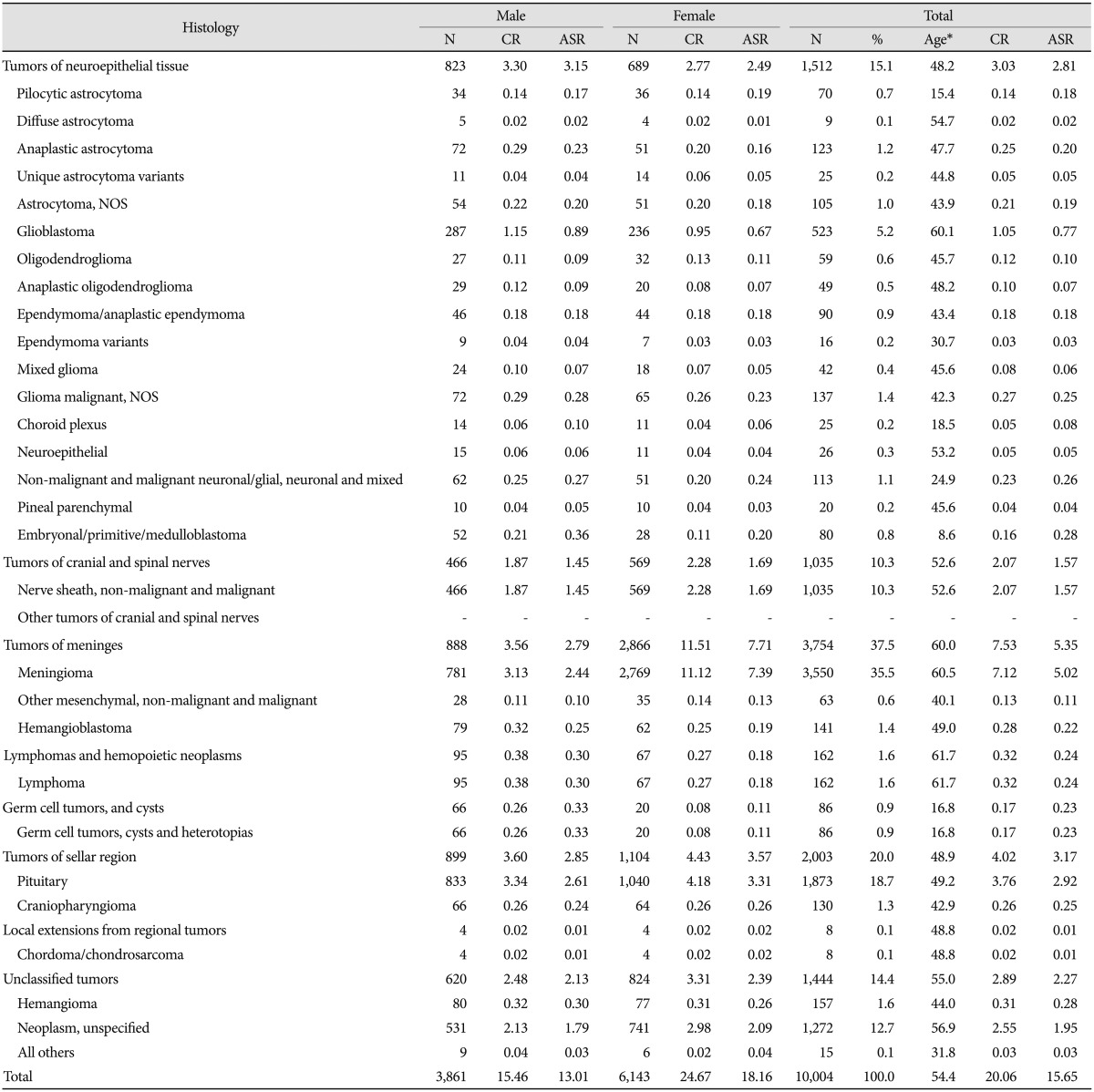
*Median age at diagnosis. CNS: central nervous system, CR: crude rate, ASR: age-standardized rate, NOS: not otherwise specified
Fig. 5.
Incidence according to sex and histology, Republic of Korea, 2010. NOS: not otherwise specified.
Fig. 1.
Distribution of primary Brain and CNS tumors according to sex and behavior, Republic of Korea, 2010. CNS: central nervous system.
Table 2.
The numbers of total and histologically confirmed cases by histological group, Republic of Korea, 2010
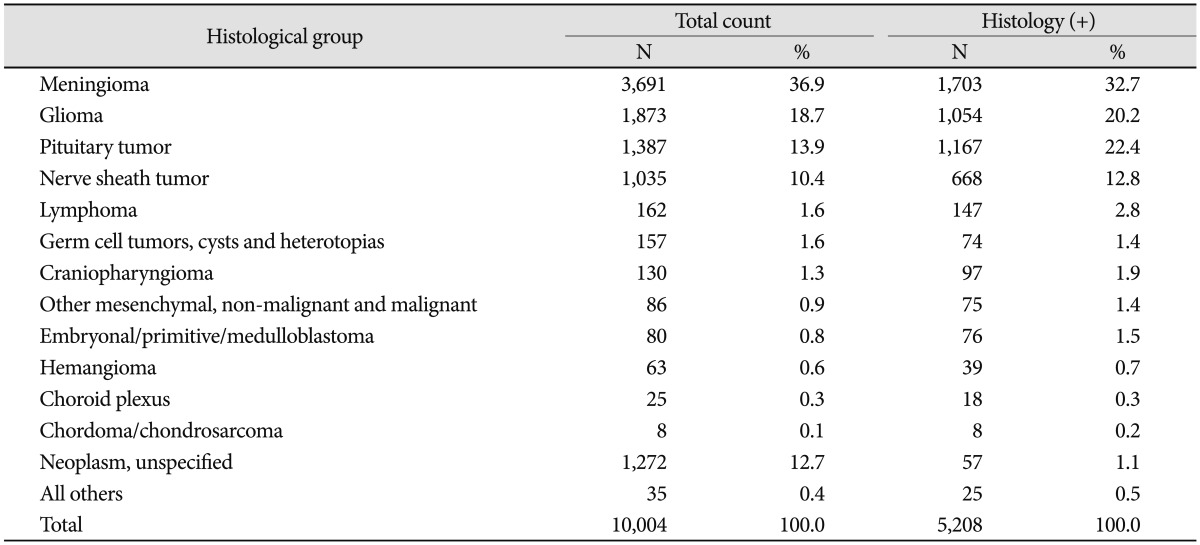
Histology (+): histologically confirmed cases
Incidence according to tumor biological behavior
The overall incidence according to biological behavior was shown in Fig. 1. The incidence in males was 38.6% and the incidence in females was 61.4%. The incidence of benign tumors was 71.0%. Benign tumors developed nearly twice more frequently in females than in males (M : F=2,359 : 4,748). In contrast, the incidences of uncertain and malignant tumors were noted to be similar.
Distribution of tumors according to the originating site
The incidence according to the originating site was shown in Fig. 2. Meninges (33.0%) were the most common site of primary brain tumors, followed by the brain parenchyma (29.8%), sellar region (21.8%), and cranial and spinal nerves (15.4%). Tumors of the meninges developed 3 times more frequently in females (Fig. 2). The other sites showed no significant differences in incidence according to sex.
Fig. 2.
Distribution of all Brain and CNS tumors according to the topography, Republic of Korea, 2010. CNS: central nervous system.
The overall incidence of primary brain tumors increased with age until the seventh decade. The incidence of each site-specific tumor according to age is shown in Fig. 3. Tumors of the brain parenchyma reached a peak in the seventh decade. Tumors of meninges seldom occurred in childhood, the incidence of which increased in the third decade and peaked in the seventh decade. Tumors of the nerves peaked in the sixth decade. Sellar tumors increased rapidly in late adolescents and peaked in the fifth decade, which decreased thereafter.
Fig. 3.
Distribution of primary brain and CNS tumors according to age for selected histology, Republic of Korea, 2010. CNS: central nervous system.
Incidence according to specific histology
Distribution of the tumors according to histology was shown in Fig. 4. Histologically, tumors of meninges were the most common (37.5%). Tumors of sellar region (20.0%) and neuroepithelial tumors (15.1%) were followed. Neuroepithelial tumors were composed of glioma, ganglioneuroma, neurocytoma, primitive neuroectodermal tumor, pineal tumor and retinoblastoma. Most of the neuroectodermal tumors were gliomas (91.7%), which accounted for 15.1% of all primary brain tumors. Glioblastoma accounted for 5.2% of all tumors and 34.4% of all gliomas. Among histologically confirmed cases, glioblastoma accounted for 40.6% of all gliomas (Table 3). Sellar tumors and nerve sheath tumors, which were confirmed by pathologists, accounted for 20.2% and 12.8%, respectively, of all tumors.
Fig. 4.
Distribution of brain and CNS tumors according to the topography and histology, Republic of Korea, 2010. CNS: central nervous system, NOS: not otherwise specified.
Table 3.
The numbers of total and histologically confirmed cases by histological type in gliomas, Republic of Korea, 2010
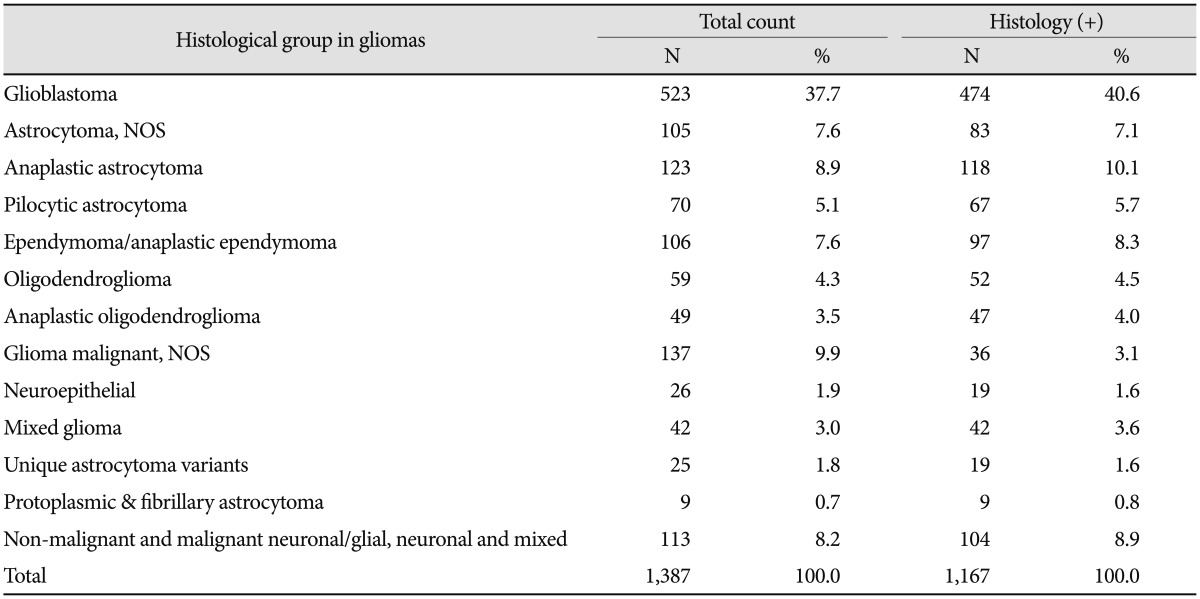
Histology (+): histologically confirmed cases. NOS: not otherwise specified
The overall incidence according to gender and histology are presented in Fig. 1. The incidence of meningioma was almost three times higher in females than in males. Nerve sheath tumor, pituitary tumor and pilocytic astrocytoma were also more common in females. On the other hand, germ cell tumor, glioma (except pilocytic astrocytoma) and lymphoma were more common in males.
We classified tumors according to CBTRUS. Unclassified tumors include unspecified neoplasms and all other tumors. Unspecified neoplasms refer to cases registered based on death certificates only. We did not have any specific data other than neoplasm in those cases. The tumors which classified into all other tumors were tumors that did not meet CBTRUS criteria. Unclassified tumors accounted for 14.4% of all CNS tumors. The detail was described in Table 1.
Distribution of childhood primary brain tumors according to histology
Distribution of tumors according to histology in childhood was shown in Table 4 and Fig. 6. The most common histology in children included neuroepithelial tumors, tumors of sellar region and germ cell tumors. Neuroepithelial tumors accounted for 45.4% of all tumors in children. Medulloblastoma was the most common tumor among neuroepithelial tumors in children. Glioblastoma accounted for only 3% of all primary brain tumors in children.
Table 4.
Incidence rates of primary CNS tumors by histology and sex in childhood (Ages 0-19), Republic of Korea, 2010
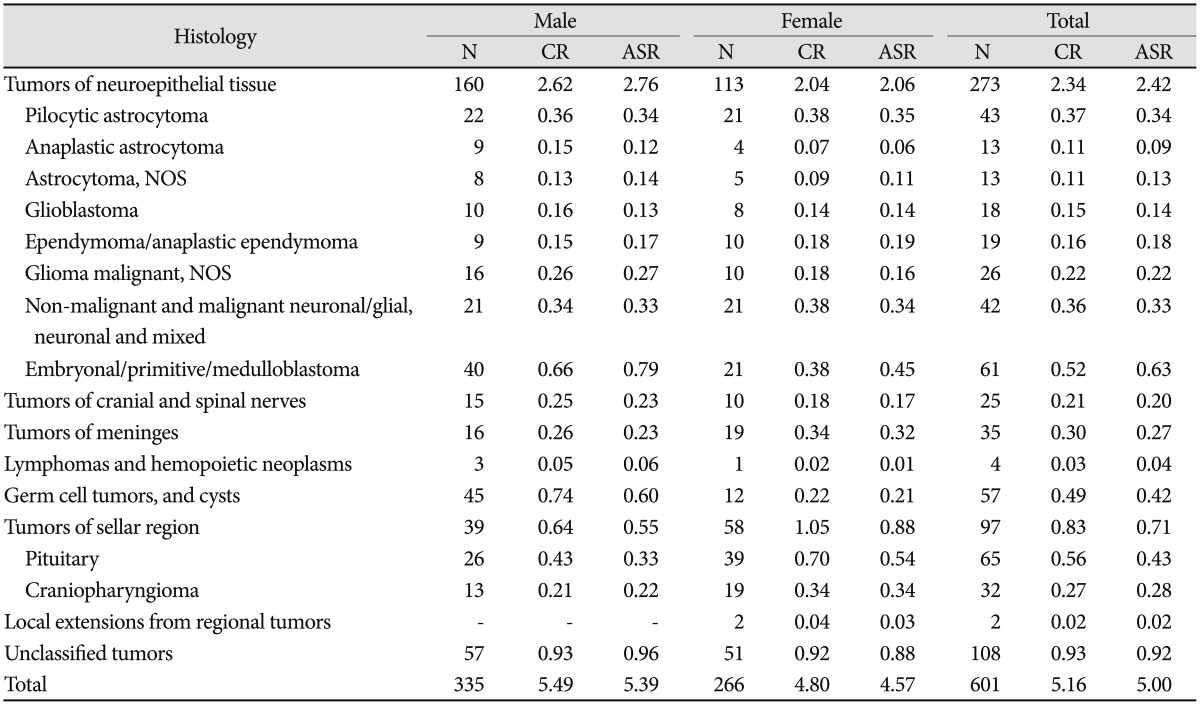
CNS: central nervous system, CR: crude rate, ASR: age-standardized rate, NOS: not otherwise specified
Fig. 6.
Distribution of primary brain and CNS tumors according to the topography and histology in children, Republic of Korea, 2010. CNS: central nervous system, NOS: not otherwise specified.
Incidence in children according to age and histology
The age-standardized incidence in children according to histology was shown in Table 4. The incidence of primary brain tumors was 5.0 per 100,000 person-years. The incidence was slightly higher in males (5.39) than in females (4.57).
DISCUSSION
This is second nationwide report on primary brain and CNS tumors, encompassing benign, borderline and malignant tumors in Republic of Korea. The overall crude rate for brain and CNS tumors in Republic of Korea was 11.69 per 100,000 person-years in 2005, and the crude rate in children was 3.63 per 100,000 person-years [9]. In 2010, those were 20.06 per 100,000 person-years and 5.16 per 100,000 person-years, respectively. Tumors of neuroepithelial tissue were increased from 599 to 823 cases. Tumors of cranial nerves were increased from 272 to 466 cases. Tumors of meninges were increased from 453 to 888 cases. Tumors of sellar region were increased from 403 to 899 cases. The incidences of all histological type were increased in 2010 compared with those of 2005. However, the main cause of steep increase in the incidences of brain tumors was benign tumors. It may be caused by early detection due to inclusion of brain MRI for routine screening test in Republic of Korea. And it seemed to be also due to that medical administrators were more accustomed to register benign tumors because five years have passed since registration of benign tumors started in 2005.
In conclusion, we updated nationwide statistics of brain and CNS tumors in Republic of Korea. These data base are mandatory for facilitating etiologic studies, establishing awareness of the disease, and ultimately, for the control of tumors.
Acknowledgments
This study was supported by the National Cancer Center Grant (NCC-1310220).
Footnotes
The authors have no financial conflicts of interest.
References
- 1.Bauchet L, Rigau V, Mathieu-Daudé H, et al. French brain tumor data bank: methodology and first results on 10,000 cases. J Neurooncol. 2007;84:189–199. doi: 10.1007/s11060-007-9356-9. [DOI] [PubMed] [Google Scholar]
- 2.Central Brain Tumor Registry of the United States. Statistical report. Primary brain tumors diagnosed in the United States in 2004-2005. [Accessed September 10, 2009]. at http://www.cbtrus.org/
- 3.Kaneko S, Nomura K, Yoshimura T, Yamaguchi N. Trend of brain tumor incidence by histological subtypes in Japan: estimation from the Brain Tumor Registry of Japan, 1973-1993. J Neurooncol. 2002;60:61–69. doi: 10.1023/a:1020239720852. [DOI] [PubMed] [Google Scholar]
- 4.Committee of Brain Tumor Registry of Japan. Report of Brain Tumor Registry of Japan (1969-1996) Neurol Med Chir (Tokyo) 2003;43(Suppl):i–vii. 1–111. [PubMed] [Google Scholar]
- 5.Hoffman S, Propp JM, McCarthy BJ. Temporal trends in incidence of primary brain tumors in the United States, 1985-1999. Neuro Oncol. 2006;8:27–37. doi: 10.1215/S1522851705000323. [DOI] [PMC free article] [PubMed] [Google Scholar]
- 6.Johannesen TB, Angell-Andersen E, Tretli S, Langmark F, Lote K. Trends in incidence of brain and central nervous system tumors in Norway, 1970-1999. Neuroepidemiology. 2004;23:101–109. doi: 10.1159/000075952. [DOI] [PubMed] [Google Scholar]
- 7.Wöhrer A, Waldhör T, Heinzl H, et al. The Austrian Brain Tumour Registry: a cooperative way to establish a population-based brain tumour registry. J Neurooncol. 2009;95:401–411. doi: 10.1007/s11060-009-9938-9. [DOI] [PubMed] [Google Scholar]
- 8.Shin HR, Won YJ, Jung KW, et al. Nationwide cancer incidence in Korea, 1999~2001; first result using the national cancer incidence database. Cancer Res Treat. 2005;37:325–331. doi: 10.4143/crt.2005.37.6.325. [DOI] [PMC free article] [PubMed] [Google Scholar]
- 9.Lee CH, Jung KW, Yoo H, Park S, Lee SH. Epidemiology of primary brain and central nervous system tumors in Korea. J Korean Neurosurg Soc. 2010;48:145–152. doi: 10.3340/jkns.2010.48.2.145. [DOI] [PMC free article] [PubMed] [Google Scholar]
- 10.Fritz A, Percy C, Jack A, et al. International classification of diseases for oncology. 3rd ed. Geneva, Switzerland: World Health Organization; 2000. [Google Scholar]
- 11.Annual report of national cancer registration. Cancer incidence in 2005 and survival for 1993-2005. [Accessed September 10, 2008]. at http://www.iarc.fr/
- 12.Segi M. Cancer mortality for selected sites in 24 countries (1950-1957) Sendai, Japan: Tohoku University School of Medicine; 1960. [Google Scholar]



